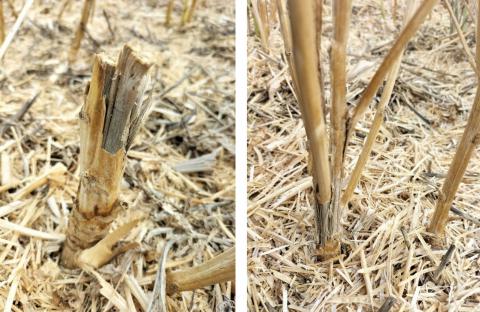Philip Walker

In Oilseed rape crops, the Phoma stem canker was easily found on susceptible varieties in untreated trial plots. The severities of the stem cankers have been moderate in susceptible varieties, but significantly reduced in resistant varieties. Yield improvements have been seen where fungicide applications were applied in the autumn to control phoma leaf infections. After harvest it is worth considering burying or incorporating stubbles and crop residues through ploughing or cultivations to reduce the production of air-borne spores of both phoma and light leaf spot. This is beneficial for the management of these diseases as both produce spores on crop debris which can infect neighbouring oilseed rape crops.
Where crops have been harvested, stubbles can be checked for verticillium stem stripe to determine whether any was present. If the tissue underneath is grey and runs in vertical lines with visible microsclerotia on the outside of the stem, this may indicate verticillium symptoms (Figure 1). As the infected stubbles breakdown this will return the microsclerotia to the soil which are capable of long-term survival. Therefore, it is useful for disease management strategies to know whether verticillium has been previously seen, which can help guide the risk for the next crop and the decision to use a resistant variety. Further information on verticillium and variety ratings can be found via the link https://ahdb.org.uk/knowledge-library/verticillium-stem-stripe-in-oilseed-rape
ACTION
- Check stubbles post-harvest for signs of verticillium and other diseases like phoma stem canker, clubroot and sclerotinia.
- Consider burying or incorporating oilseed rape stubbles to decrease spore production for both phoma and light leaf spot. Spores produced on crop debris can infect neighbouring oilseed rape crops.
